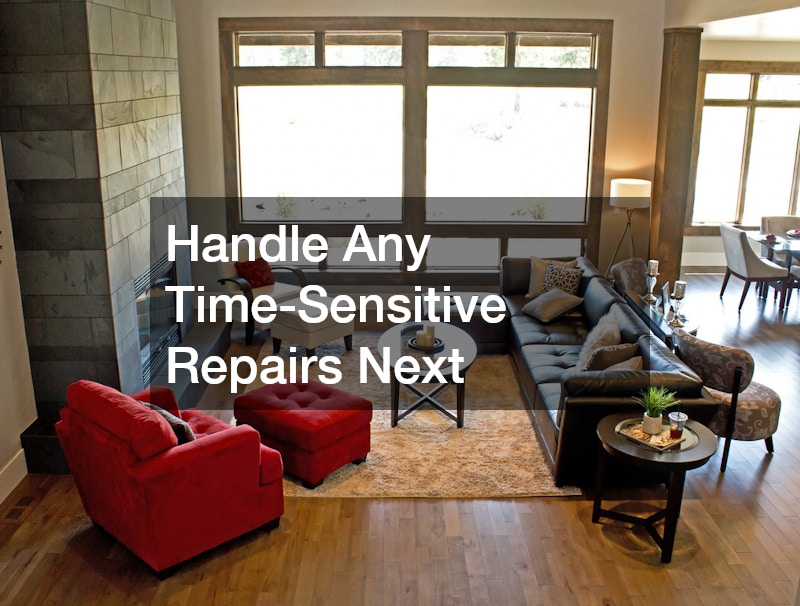Moving into a new home is a major milestone, filled with excitement, relief, and the anticipation of creating a space that reflects your lifestyle. Yet once the boxes are stacked high and the moving truck pulls away, many homeowners quickly realize that the real work is only beginning. Every home—new or old—comes with a list of tasks, adjustments, improvements, and repairs that demand attention. The challenge lies not in recognizing what needs to be done, but in figuring out what should be done first.
A new home can feel overwhelming because everything seems important at once. Whether you’re dealing with safety concerns, aesthetic upgrades, functional improvements, or long-term planning, prioritizing projects helps you stay organized and protects your investment. Without a system, you may focus on cosmetic updates while overlooking urgent structural or safety issues. A clear prioritization strategy ensures projects get done efficiently, financially responsibly, and in a way that supports long-term home stability.
When you know how to prioritize properly, you gain control of your home environment from the very beginning. You avoid unnecessary stress, prevent costly mistakes, and build a stronger foundation for years of comfortable living. Understanding which projects require immediate action versus those that can wait is essential for new homeowners who want to make smart and strategic decisions.

Start With a Whole-Home Assessment
Before making any decisions about upgrades or repairs, new homeowners should begin with a comprehensive home assessment. This step allows you to identify potential areas of concern, understand the general condition of your home, and create a structured plan based on real needs rather than guesswork.
Walk Through Every Room
Start with a walkthrough of every interior space. Take notes on:
• Wall condition
• Ceiling discoloration
• Window function
• Door condition
• Flooring stability
• Closet storage
• Lighting condition
• Possible water damage
Even homes that appear “move-in ready” often have minor imperfections or hidden problems only noticeable to a fresh set of eyes.
Inspect the Exterior
The home’s exterior is just as important as the interior. Look for:
• Cracks in siding
• Signs of moisture damage
• Damaged gutters
• Missing caulk
• Cracked concrete
• Leaning fences
• Damaged screens
• Loose soil around the foundation
The exterior determines how well your home withstands weather and environmental changes.
Evaluate Safety Risks
Before anything else, you should ensure your home is safe to occupy. Safety risks include:
• Exposed wiring
• Mold
• Loose railings
• Broken locks
• Pest entry points
• Carbon monoxide threats
• Fire hazards
Homes are sometimes sold with quick cosmetic fixes that hide underlying problems. A full assessment exposes them early.
Many homeowners contact roofing companies at this stage if they spot storm damage or worn shingles that need immediate attention.
Identify All Health and Safety Priorities First
Health and safety issues should always take top priority after moving in because they affect the home’s livability. Even if they are not immediately obvious, these problems can escalate quickly and become dangerous if ignored.
Air Quality Concerns
New homeowners should check for:
• Mold
• Musty odors
• Poor ventilation
• Dust accumulation
• Airborne allergens
If you suspect any air quality issues, address them immediately. Poor air quality negatively affects sleep, breathing, and overall well-being.
Electrical Safety
Electrical hazards pose a serious risk and must be addressed quickly. Look for:
• Flickering lights
• Burnt outlets
• Overloaded panels
• Exposed wiring
• Frequent breaker trips
Do not delay making repairs. Electrical issues can lead to fires or appliance failures. Homeowners who need professional help often reach out for electrician services when their new home reveals wiring concerns.
Structural Safety
Cracks in walls or flooring could indicate deeper foundation issues. Sagging ceilings, soft flooring, or bowing walls should be evaluated quickly because they may signal structural deficiencies.
Gas and Plumbing Issues
Gas leaks and plumbing failures also present immediate hazards. If pipes show signs of corrosion, leaks, or low pressure, take action fast. Some homeowners contact plumbing companies at this stage to evaluate hidden pipe issues, sewer line concerns, or fixture malfunctions.
By taking care of health and safety needs first, you protect your home and your family from preventable dangers.

Handle Any Time-Sensitive Repairs Next
After identifying and resolving all health and safety issues, shift your focus toward time-sensitive repairs. These include problems that may not be immediately dangerous but have the potential to worsen quickly or create costly damage if neglected.
Roof Leaks and Water Damage
Small roof leaks can cause major structural damage when ignored. Time-sensitive moisture-related issues include:
• Ceiling stains
• Soft wall patches
• Damp insulation
• Leaks near vents or chimneys
Early attention prevents mold and wood rot.
HVAC System Concerns
Heating and cooling systems require immediate care if they show signs of:
• Weak airflow
• Noisy operation
• Foul odors
• Uneven temperatures
• Rising energy bills
Proper servicing helps your system last longer and lowers utility costs. Many homeowners schedule HVAC service shortly after moving to ensure comfort through seasonal changes.
Windows and Exterior Doors
Doors and windows that don’t seal correctly can cause:
• Drafts
• Higher utility bills
• Pest entry
• Water leaks
• Security issues
Some new homeowners discover problems with a sliding glass door that fails to lock properly or doesn’t glide smoothly.
Major Appliance Problems
Refrigerators, stoves, washers, and dryers can show symptoms of impending failure. Replacing or repairing appliances early prevents inconvenient breakdowns.
Focus on Projects That Improve Daily Functionality
After addressing urgent repairs, the next step is enhancing your home’s daily livability. Projects that affect your comfort, organization, and workflow should be prioritized because they impact your everyday experience.
Organizational Systems
Organizing your new home makes everything easier. Consider improvements like:
• Adding shelving
• Replacing closet rods
• Installing storage units
• Improving pantry space
Good organization reduces clutter and increases efficiency.
Lighting Upgrades
The right lighting changes everything. Consider:
• Replacing dim bulbs
• Updating outdated fixtures
• Installing LED lighting
• Adding task lighting in kitchens and offices
Better lighting improves mood and functionality.
Smart Home Systems
Many homeowners prioritize smart home upgrades early because they improve convenience and safety. Popular additions include:
• Smart thermostats
• Video doorbells
• Smart locks
• Wi-Fi extenders
• Motion sensors
Smart systems help you control your home from anywhere.
Flooring Improvements
Your flooring has a huge impact on comfort and cleanliness. If you notice worn carpets, cracked tiles, or uneven hardwood, you may want to call a flooring company to assess replacement or repair options.
Kitchen and Bathroom Efficiency
You don’t have to remodel immediately, but improving faucets, cabinet hardware, or lighting can make a big difference in usability. Upgrades like pull-out shelves or improved ventilation enhance everyday enjoyment.

Plan Exterior Projects Strategically
Exterior projects are essential for protecting your home from the elements and increasing curb appeal. Prioritizing them correctly ensures your home’s structure remains strong.
Landscape Cleanup
After moving in, assess the yard to remove debris, overgrown branches, and hazards. This step helps prevent pests and improves visibility.
Some homes require assistance from a tree removal contractor if large or damaged trees threaten the property.
Gutter and Drainage Systems
Improper drainage can lead to foundation damage. Clean gutters and inspect downspouts to protect the home’s structure.
Driveway Repairs
If your driveway has cracks or uneven areas, address them early to prevent worsening damage.
Garage Door Condition
A malfunctioning garage door affects convenience and security. Many homeowners schedule garage door installationsshortly after moving if the door is outdated or unreliable.
Exterior Washes and Repairs
Pressure washing, repainting trim, or fixing damaged siding helps maintain your exterior and prevents weather-related deterioration.
Address Comfort-Based Projects Once Essentials Are Covered
Once safety, functionality, and exterior maintenance are handled, turn your attention to projects that improve your daily comfort and enjoyment of the home.
Interior Design Updates
Comfort-driven changes include:
• Choosing new furniture
• Updating window treatments
• Adding artwork
• Installing new décor
• Replacing decorative lighting
These projects make your home feel truly yours.
Painting Rooms
Painting is one of the most affordable ways to dramatically change a space. A fresh coat of paint enhances mood and aesthetics. Many homeowners hire painting contractors to ensure clean lines, even coverage, and durable finishes.
Improving Energy Efficiency
Energy efficiency projects enhance comfort and reduce long-term costs. Consider:
• Adding insulation
• Upgrading windows
• Installing ceiling fans
• Sealing air leaks
These upgrades make your home more environmentally friendly.
Storage Upgrades
Adding built-in shelving, garage storage, or attic organization helps you maintain a clutter-free home.

Tackle Value-Boosting Projects After You Settle In
Once you’ve lived in your new home for a few months, you’ll have a better sense of what long-term improvements are worth investing in. Value-boosting projects can significantly enhance resale value and overall satisfaction.
Kitchen Renovations
Kitchens are a major selling point for homes. Consider upgrades like:
• Replacing countertops
• Installing modern appliances
• Updating cabinets
• Adding backsplashes
A well-planned kitchen renovation increases functionality and value.
Bathroom Upgrades
Bathrooms benefit from improvements such as:
• New vanities
• Updated lighting
• Re-tiled showers
• Improved ventilation
Small bathroom upgrades can greatly enhance comfort.
Basement Finishing
Finishing a basement adds living space and increases resale value. It can be used as a guest suite, gym, office, or entertainment area.
Outdoor Living Enhancements
Outdoor improvements such as decks, patios, pergolas, and fire pits make your home feel larger and more inviting.
Rank Projects by Budget Requirements
Budget plays a major role in project prioritization. Some projects are affordable and quick to complete, while others require significant financial planning.
Low-Cost Projects
These projects provide quick wins without breaking your budget:
• Painting walls
• Replacing hardware
• Updating lighting
• Basic landscaping
• Organizing closets
These improvements deliver immediate satisfaction.
Moderate-Cost Projects
Projects in this range require more financial planning:
• Flooring updates
• Appliance replacements
• Outdoor lighting
• Mid-level bathroom upgrades
• Garage storage systems
Moderate projects offer functional and visual improvements.
High-Cost Projects
Major renovations or replacements include:
• Roof replacement
• Siding updates
• HVAC upgrades
• Kitchen remodels
• Full landscaping redesigns
Large projects should be prioritized based on urgency and long-term value.
Some homeowners turn to a restoration company when unexpected issues like water damage or structural concerns arise, increasing the financial priority of those repairs.
Consider the Lifespan and Condition of Every Home Component
Home systems and materials have predictable lifespans. Prioritizing based on remaining lifespan helps you avoid expensive emergencies.
Roof Lifespan
Most roofs last 20–30 years depending on materials. If you move into a home nearing the end of the roof’s life, budget for replacement sooner rather than later.
HVAC Lifespan
Heating and cooling systems generally last 10–15 years. Pay attention to noise, efficiency, and temperature consistency.
Water Heaters
Traditional tank heaters last 8–12 years, while tankless systems last up to 20.
Exterior Siding
Vinyl siding can last decades, but wood siding needs more frequent care.
Windows and Doors
Older windows lose energy efficiency over time.
Flooring
Carpet may need replacing every 5–10 years, while hardwood can last decades with proper care.
Knowing the lifespan of your home’s features helps you plan ahead and avoid being caught off guard.
Use a Three-Tier Priority System to Stay Organized
A long-term prioritization strategy helps you stay on track throughout your first year in the home.
Tier 1: Urgent and Safety-Related Projects
These require immediate attention:
• Mold removal
• Electrical hazards
• Gas leaks
• Structural weaknesses
• Broken locks
• Roof leaks
Address these before anything else.
Tier 2: Functional Improvements
These enhance daily living:
• Lighting updates
• Flooring repair
• Appliance installation
• Organization systems
These can be prioritized based on need and budget.
Tier 3: Aesthetic and Lifestyle Enhancements
These projects improve comfort and style:
• Painting rooms
• Landscaping
• Furniture upgrades
• Décor and lighting
These can wait until essential tasks are complete.
When to Hire Professionals and When to DIY
Not every home project requires professional help, but some absolutely do. Knowing when to DIY and when to call in experts protects your home and prevents costly mistakes.
DIY-Suitable Projects
• Painting furniture
• Installing shelves
• Hanging artwork
• Minor gardening
• Replacing lightbulbs
• Basic décor updates
DIY projects save money and allow for creativity.
Professional-Required Projects
Some projects are too dangerous or complex for DIY. These include:
• Electrical work
• Gas line repairs
• Major plumbing issues
• Large-scale home restoration
• Roof repairs
• Structural improvements
Working with professionals ensures safety and quality work.
Some new homeowners choose to hire painting contractors when they want high-quality finishes without the hassle of prepping, taping, and painting multiple rooms themselves.
How to Build a Realistic Project Timeline
Creating a timeline helps avoid stress, budget overload, and project imbalance.
Monthly Breakdown
Assign certain tasks to specific months to avoid doing everything at once.
Seasonal Planning
Some projects are best completed during certain seasons:
• Summer: exterior painting, landscaping
• Fall: HVAC prep, gutter cleaning
• Winter: interior upgrades, organizing
• Spring: window repair, roof inspections
Year-One Expectations
Expect to complete most urgent and functional tasks in your first year. Spread out other projects to avoid financial strain.
Avoid the Most Common New-Home Project Mistakes
Many new homeowners make predictable mistakes in their first year—mistakes that lead to overspending or overlooked safety issues.
Mistake 1: Focusing Too Much on Aesthetics
A beautiful home with hidden structural issues can quickly turn into a financial nightmare.
Mistake 2: Ignoring Professional Evaluations
Skipping professional inspections leads to missed red flags.
Mistake 3: Over-Renovating Too Soon
Living in the home for a while helps you understand what you truly want.
Mistake 4: Hiring the Wrong Contractors
Always research before hiring professionals.
Mistake 5: Underestimating Costs
Unexpected repairs commonly occur within the first year.
Creating a Home Project Budget That Works
Budgeting plays a crucial role in project prioritization.
Track All Estimates
Collect written quotes for big projects.
Categorize Costs
Divide into urgent, functional, and aesthetic.
Plan for Unexpected Repairs
Set aside emergency funds.
Evaluate Your Long-Term Goals
Decide what you want your home to be in five years.
Use Tools and Apps
Home management apps help track costs and timelines.
Moving into a new home unlocks countless opportunities to customize, improve, and create a space that truly reflects who you are. But without a clear plan, the endless list of projects can quickly become overwhelming. By prioritizing safety first, addressing time-sensitive issues, improving functionality, and gradually upgrading comfort and aesthetics, homeowners create a balanced approach that makes the first year manageable and rewarding. With thoughtful planning, the right professionals, and realistic timelines, every project becomes a meaningful investment in your home’s future.



